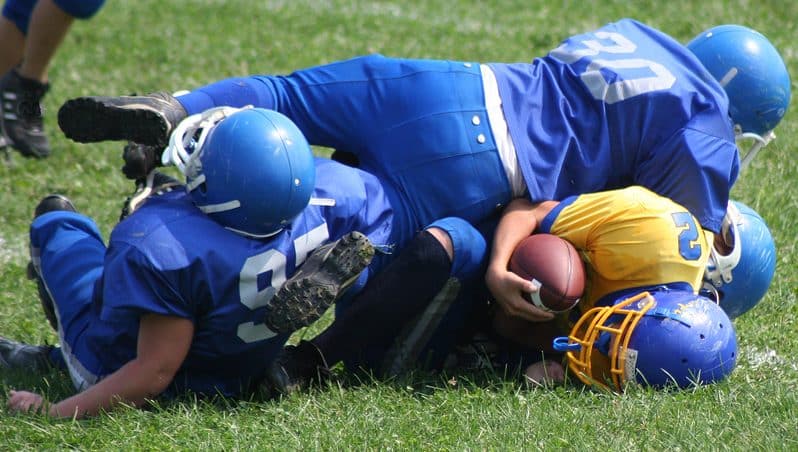The cumulative effects of small impacts may result in decreased brain development in children between 9 and 18, causing lifelong effects.
Researchers at Dallas’ UT Southwestern Medical Center examined dozens of youth football players who had no history of head injuries. Gowtham Krishnan Murugesan and his team found that small, repetitive blows to the head, like the ones that occur on practically every snap in every practice and game, interfere with the natural pruning process. “Pruning is an essential part of brain development” since it trims away unneeded parts of the brain to keep the organ healthy, he explained. “Disruption in normal pruning has been shown to be related to weaker connections between different parts of the brain,” he added. Specifically, the repetitive impacts eroded grey matter. This is the area of the brain that controls most logical and social functions.
Researchers pointed out that the findings were preliminary and they applied to all contact and non-contact youth sports.
What Causes Head Injuries?
Each year, over 2.8 million Americans seek treatment in hospital emergency rooms following sudden trauma brain injuries. This number does not include the many New Yorkers who suffer from gradual-onset brain injuries, like the ones described in the above stories.
A brain injury is not just a knock on the head. These wounds contribute to around a third of the injury-related deaths in the United States.
Car crashes cause most of these brain injuries. That’s largely because vehicle collisions combine all three kinds of brain injury causes, which are:
- Impact: Airbags protect many occupants from head injuries. But airbags do not offer much protection for back seat passengers. This safety system also does not prevent cell phones and other items from becoming high-speed missiles in car wrecks.
- Motion: It’s possible to scramble the brain without breaking the skull, just like it’s possible to scramble an egg without cracking the shell. Whiplash is one of the most common car crash conditions. It’s also difficult to diagnose and treat.
- Noise: Many eyewitnesses and victims say the sound of a car crash is like an explosion. Loud noises like these trigger shock waves which disrupt brain functions. So, even if the victim is otherwise uninjured, the victim may still have a serious head injury.
Falls are the leading cause of impact-related brain injuries. These individuals have no airbags or seat belts for protection. They also do not have crash helmets or any other type of protection.
Assaults cause quite a few head injuries as well. Many assaults involve multiple impacts to the head and neck. Since they are intentional torts, these claims work differently from most negligence cases. However, substantial compensation is still available.
Finally, sports-related brain injuries are on the rise. Scientists now appreciate he dangers of concussions as well as smaller hits.
Insurance Company Defenses in Head Injury Cases
In vehicle collisions, insurance company lawyers often try to use the contributory negligence defense. This doctrine basically shifts blame for the crash from the tortfeasor (negligent driver) to the victim. For example, one driver might have been speeding at the time the other driver changed lanes illegally.
New York is a pure comparative fault state. Even if the victim is 99 percent responsible for the crash, the victim is still entitled to a proportional share of damages.
In falls, sports injuries, and other premises liability matters, insurance company attorneys often raise the assumption of the risk defense. This legal loophole excuses otherwise negligent conduct if the victim:
- Voluntarily Assumes: Many times, the victim must sign a liability waiver as a condition of participation in a certain activity. These waivers are usually not “voluntary.” Instead, they may be characterized as take-it-or-leave-it contracts of adhesion. Furthermore, if the victim paid money to participate in the activity, the waiver may be void as a matter of law.
- A Known Risk: In something like a youth football league, a knee injury is a known risk. A gradual-onset head injury is definitely not a known risk. That’s especially true if the organization dragged its feet in terms of participant safety. Many times, that’s the case.
With regard to most insurance company defenses, the judge makes an initial determination as to the defense’s possible application. Then, the jury decides if the facts call for the defense.
Damages in head injury cases usually include compensation for economic losses, such as medical bills, and noneconomic losses, such as pain and suffering. Since brain injuries are permanent and difficult to treat, these damages are often substantial.
Anyone at any time can sustain a serious brain injury. For a free consultation with an experienced personal injury attorney in New York, contact Napoli Shkolnik PLLC. We handle brain injury cases on a nationwide basis.
